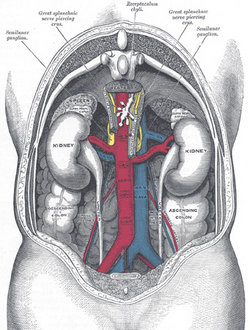Urinary system
|
|
| Contents |
Physiology
Kidneys
The kidney is one of the various organs (together with the lungs, intestine and skin) that participates in the elimination of the wastes of the organism. The kidneys are bean-shaped organs about the size of a human fist. They are near the middle of the spine, just below the ribcage.
A kidney consists of about 1 million filtering units termed nephrons, each consisting of a glomerulus, ball-shaped network of capillaries, and a network of tubules. Blood is filtered by the glomerulus, and the resultant "prourine" passes through the tubular system where water, electrolytes and nutrients are reabsorbed.
Humans produce about 1.5 liters of urine over 24 hours, although this amount may vary according to the circumstances. Increased fluid intake generally increases urine production, while increased perspiration and respiration may decrease the amount of fluid excreted through the kidneys. Some medications interfere directly or indirectly with urine production, such as diuretics.
The kidney plays a crucial role in regulating electrolytes in the human blood (e.g. sodium, potassium, calcium). In addition, it clears urea, a nitrogenous waste product from the metabolism of amino acids.
Ureters
Urine is collected in the renal pelvis (or pyelum), which connects to the ureters, which carry urine to the bladder. The ureters are about 8 to 10 inches (200 to 250 mm) long. Smooth muscular tissue in the walls of the ureters peristaltically force the urine downward. Small amounts of urine are emptied into the bladder from the ureters about every 10 to 15 seconds.
Bladder
The urinary bladder is a hollow muscular organ shaped like a balloon. It is located in the pelvic fossa and held in place by ligaments attached to the pelvic bones.
The bladder stores urine; it swells into a round shape when it is full and gets smaller when empty. In the absence of bladder disease, it can hold up to 16 fluid ounces (500 ml) of urine comfortably for 2 to 5 hours.
Sphincters (circular muscles) regulate the flow of urine from the bladder. The bladder itself has a muscular layer (detrusor muscle) that, when contracted, increases pressure on the bladder and creates urinary flow.
Urination is a concious process, generally initiated by stretch receptors in the bladder wall which signal to the brain that the bladder is full. This is felt as an urge to urinate. When urination is initiated, the sphincter relaxes and the detrusor muscle contracts, producing urinary flow.
The prostate is a small gland around the bladder neck in men. It plays no role in urination, but may become enlarged (benign prostatic hyperplasia or prostate cancer) and interfere with normal urination.
Role in disease
Kidney diseases are normally investigated and treated by nephrologists, while the specialism of urology deals with problems in the other organs. Gynecologists may deal with problems of incontinence in women.
Diseases affecting the urinary system:
- There are numerous kidney diseases, many of which interfere with the normal production of urine. Renal failure may be acute or chronic, and may require medication and dialysis.
- Kidney stones may be painful and cause long-term kidney damage. Proteinuria is usually without symptoms but may indicate renal disease.
- Stenosis (blockage), reflux (backflow of urine into the kidney, causing damage)
- Urinary tract infections (UTIs), interstitial cystitis, incontinence (involuntary loss of urine), benign prostatic hyperplasia, prostatitis (inflammation of the prostate) and urinary retention (inability to pass urine).
Testing
Urinalysis is a test that studies the content of urine for abnormal substances such as protein or signs of infection. This test involves urinating into a special container and leaving the sample to be studied.
Urodynamic tests evaluate the storage of urine in the bladder and the flow of urine from the bladder through the urethra. It may be performed in cases of incontinence or neurological problems affecting the urinary tract.
Ultrasound is commonly performed to investigate problems of the kidney and/or urinary tract. KUB is plain radiography of the urinary system, e.g. to identify kidney stones. An intravenous pyelogram studies the shape of the urinary system.
Anatomy Clipart and Pictures
- Clip Art (https://classroomclipart.com)
- Anatomy Illustrations (https://classroomclipart.com/clipart/Illustrations/Anatomy.htm)
- Anatomy Clipart (https://classroomclipart.com/clipart/Anatomy.htm)
- Anatomy Animations (http://classroomclipart.com/cgi-bin/kids/imageFolio.cgi?direct=Animations/Anatomy)



